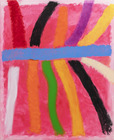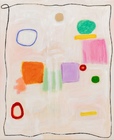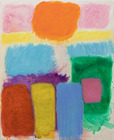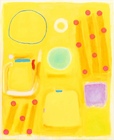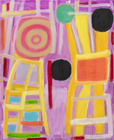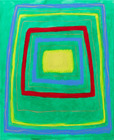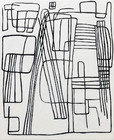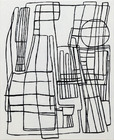Angela Brennan: Tête-à-tête & Vis-à-vis
By Amelia Winata
Angela Brennan’s massive canvases almost kiss the ceiling of her home studio. Huge shapes dance across the picture surface, as though untethered from the layers of oil paint below. A blurry-edged orange square softly dissolves into a milky sea below, a wobbly crimson stripe hovers above a fuchsia pink sky. Somewhat apologetically, Brennan tells me her work is formalist. Although she really need not apologise for identifying her practice as such. To be formally inclined is not necessarily to be shackled to the conventions of a male-dominated, hard-edged abstraction. Nor is it tube a slave to decoration, to the vacuousness of form over substance. What the viewer comes to realise when viewing Tête-à-tête & Vis-à-vis is that Brennan’s work rewrites the stale narrative that dominates the history of formalism. In the artist’s own words, these paintings represent “ontological states of being”, brimming with life and energy.
Take, for example, A finely tuned universe 2023, a scaled-up version of an earlier painting Sometimes and always 2023. For A finely tuned universe, Brennan has roughly followed the shape of the canvas to paint five rectangles that sit inside one another. A central solid yellow form radiates from the core of the work. In this sense, Brennan establishes a Möbius strip of types. This central yellow form may be the conclusion to the rectangles, growing smaller just as stacking dolls do. Or, it could just as well be the epicentre, with the subsequent rectangles representing the shockwaves that come from the painting’s core. To be sure, the idea of generations is integral to A finely tuned universe. As Brennan puts it, it is a work that is the ‘big sister ‘of the smaller painting Sometimes and always. Perhaps just as important, the characterisation of A finely tuned universe as the big sister is an anthropomorphism –it imbues the paintings with human-like qualities that lead it to endear itself to us, the viewers.
To recognise Brennan’s work as inherently linked to what came before is to recognise one of the most critical elements of her practice. It situates her within a camp of soft abstractionists who are interested in growth within cycles as opposed to problems and resolutions. To underscore this point, let us consider Brennan’s enduring preoccupation with the black line. Taking a cursory look through Brennan’s back catalogue, we notice a black, string-like border crop up from time-to-time, painted freehand around the canvas’s edge. Leitmotifs, such as this border, are constant throughout Brennan’s works, even if her style of abstraction has shifted over the decades. In Tête-à-tête & Vis-à-vis the black line appears once more in String theory2023. In this instance, the line includes a single twist in the top left corner and has-been painted with a delicate fineness that threatens to sink into the fleshy pink below or to dissolve into the chalky white overlayed in parts.
Of course, there are other obvious ‘Brennanisms’ in these works that have always been there and will continue to be there into the future – the square, the circle, the fuzzy application of oil paint. We might say that the artist’s practice is concerned with the logic of revisitation that seeks to distance the idea of ‘progress’ from a dominant narrative of start to finish, or A-to-B.
The logic of revisiting is even more critical in Tête-à-tête & Vis-à-vis. This is because for this particular exhibition, Brennan has responded to a piece of furniture at the Art Gallery of Ballarat, a mid-20th century reproduction of a 19th century conversation couch, that Brennan recalls seeing as a teenager when she attended life drawing classes at the Gallery. The artist is not so much interested in the couch’s history perse, but in the idea of iterations – this new sculpture, Tête-à-tête 2023, is responding toa reproduction that in turn responded to an original. Having turned her attention instead to the couch’s form, she does not really care for the function of the referent conversation couch – she does not want people to sit on the sculpture, seeing it as occupying ‘the cusp of unsuitable furniture’.
Reconsidered by Brennan as a minimalist stainless-steel sculpture, the couch has been reduced to a pinwheel shape. With its shiny silver finish, it evokes movement despite its stasis. In other words, because it has been pared back, removed of the colonial decoration of its referent, Tête-à-tête’s form has become its central focal point. In this sense, the sculpture mirrors Brennan’s paintings in so far as it suggests aliveness. In the same space as Tête-à-tête are two paintings, Why is that? 2023 and Tell me more 2023, that contain the same frenetic energy as the sculpture. It is only with these titles, which make a tongue-in-cheek reference to old-fashioned psychoanalysis, that Brennan acknowledges the function of the conversation couch.
It is funny that formalism is often synonymous with finitude because Angela Brennan’s work is always in the making. It is brimming with energy and life. How might we reconcile this apparent disjuncture? On the one hand, we might simply reject the idea of a formalism defined by a patriarchal hard-edged style as having any validity, while at the same time, we would also do well to accept formalism as a potential beacon, as a style that refers to something outside its very immediate shapes and colours.
Recently, Brennan has been listening to cosmology and astrophysics podcasts while painting and she has described the way in which the study of space – its structure, the history of the universe – is rooted in mathematics and science despite its overarching bizarreness and ultimate unknowability. In other words, mystery clashes with absolute empiricism. This thirst for something tangible, while hard to grasp, comes through in Brennan’s works. They shimmer beyond the frame they inhabit and point towards something that is always on the cusp of being there, of being named, and yet disappears just as quickly.
Amelia Winata is a Melbourne-based writer and curator. She is currently Curator in Residence at Gertrude and is a founding editor of Memo Review. In 2023, Amelia completed a PhD at the University of Melbourne on the post-war West German artist Charlotte Posenenske.













